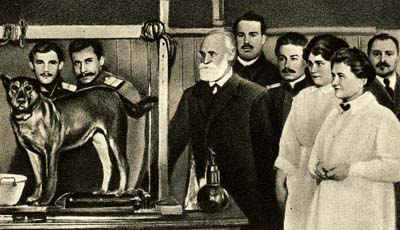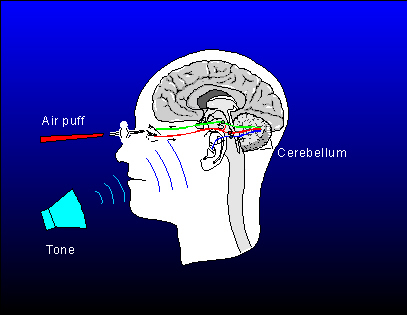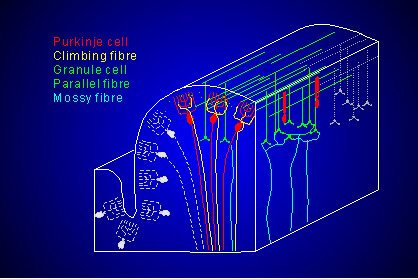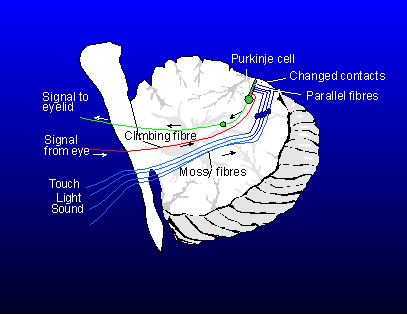|
|
| Background |
| Conditioned eyeblink |
| Learning mechanism |
| Current research Other research groups |
|
About a hundred years ago, the russian physiologist Ivan Pavlov first described the learning of a conditioned response. When a dog was fed, the entry of the food into the mouth elicited a reflexive salivation response. If the dog regularly heard a sound just before feeding, it learned to associate the sound with the food. After a while, the sound acquired the ability to elicit the salivation - a conditioned response. |
 Pavlov and his collaborators in
St.Petersburg around 1900
Pavlov and his collaborators in
St.Petersburg around 1900 |
| Pavlov and many of those who later worked on conditioning thought that the mechanisms underlying this learning also underlie other kinds of associations. Stimuli which have been paired with dangerous situations may cause anxiety, for instance. Words can acquire meaning for a child by being repeatedly paired with the object to which the word refers. An ashtmatic whose airways react to the strong smell of a flower may begin to react to the image of a flower. |
|
Many laboratories today study the learning of conditioned blink responses. A human subject or an animal is subjected to an air puff directed to the eye, which elicits a blink reflex. If the air puff is repeatedly preceded by another stimulus, say a tone, the tone will eventually itself elicit a blink just before the air puff. The eye is hereby protected against the unpleasant stimulus. |
 Learning of conditioned blink. Air puff is preceded by a
tone. After about twenty paired stimuli, the tone alone will elicit a
blink. Learning of conditioned blink. Air puff is preceded by a
tone. After about twenty paired stimuli, the tone alone will elicit a
blink. |
| Pavlov thought that the learning mechanism was located in the cortex of the forebrain, but evidence from recent years suggest that the association is formed in the cerebellum. It is not known exactly how this comes about, but a plausible working hypothesis is described below. |
|
Just under the folded surface of the cerebellum lie the Purkinje cells which send impulses out from the cerebellum. Small groups of these cells control specific muscles. One group, for instance, controls blinking. A Purkinjecell is controlled by impulses which come from different sense organs via mossy fibres, granule cells and parallel fibres. A couple of hundred thousand parallel fibres contact each Purkinje cell. This arrangement permits associations between a wide range of different stimuli and a specific movement. The contact points (synapses) between parallel fibres and Purkinje cells can be strengthened and weakened during learning. This occurs when impulses in the parallel fibres arrive at about the same time as impulses in the climbing fibres. |

Arrangement of nerve cells in the cerebellar cortex. Mossy fibres and parallel fibres send signals about events in the environment to Purkinje cells which control the blink. Climbing fibres signal that something threatens to damage the eye. |
| Before learning of a conditioned blink response, the nerve impulses in those parallel fibres which are activated by a tone have no effect on the Purkinje cells controlling blink. When the eye is stimulated by the air puff at simulataneously with the tone, climbing fibres to these cells are activated. This causes the contact between the tone-activated parallel fibres and the Purkinje cell to change, so that the tone in future will be able to elicit a blink on its own. Since there are parallel fibres which signal other kinds of stimuli, such as light or touch, these can also be made to elicit blinks by pairing them with an air puff. |
 Cerebellum. Only those stimuli which are paired
with signals in the climbing fibres will learn to influence the
Purkinjecellen.
Cerebellum. Only those stimuli which are paired
with signals in the climbing fibres will learn to influence the
Purkinjecellen. |
| Current research |
| Currently, research is focused on testing the hypothesis described above and clarifying the details of the learning mechanism. For instance, we and other research groups are trying to |
|
|
|
|
| Back to beginning of page |